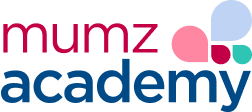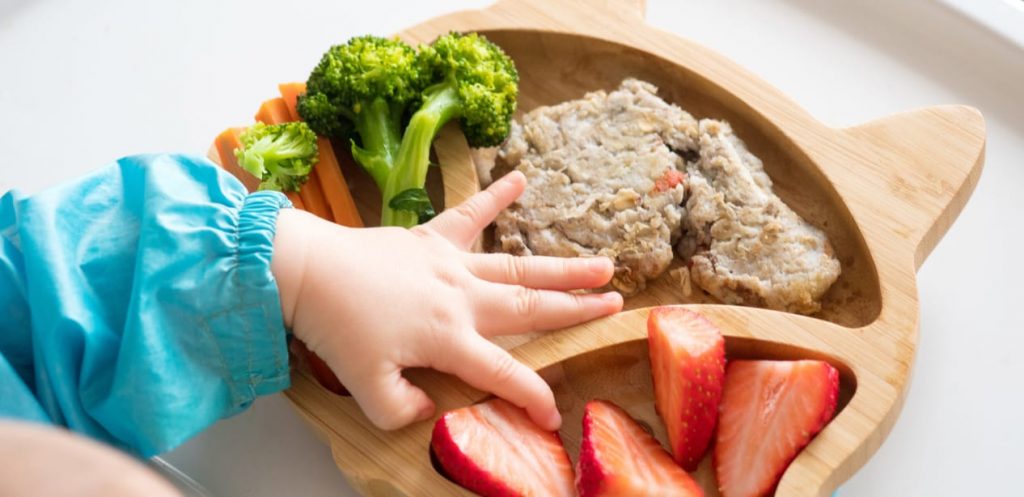What is baby-led weaning, and does it have any benefits? How to deal with it correctly? Everything you need to know from the experts!
What is baby-led weaning and how is it different from regular weaning?
Baby-led weaning is a way of introducing solid foods to babies without purees or spoon-feeding. Parents offer baby chips or finger-shaped slices of food and baby feeds herself. Baby sits at the table with the rest of the family and everyone eats together, often eating much the same food (minus the salt and a few other things that the baby can’t have). Parents can enjoy eating by themselves (and model doing so) rather than spending the whole meal trying to spoon feed into the baby!
What are the benefits?
Other than the fact that you can actually enjoy your own meal rather than needing to feed the baby, there are lots of benefits of baby-led weaning! It encourages independence and self-feeding from the start. Also, it enables the baby to continue to follow his or her body’s hunger and satiety cues (just as they do during breastfeeding), with no risk of an adult trying to override them and get “just a little bit more” in.
This may limit some of the food battles and control issues which can lead to picky eating later in childhood, and just sets up healthy eating habits from the start. Along the same lines, messy play with food seems to reduce picky eating, and baby-led weaning certainly offers lots of opportunities for making messes with food!
Is this a fad?
Baby-led weaning was first “identified” by Gil Rapley in her 2008 book on the topic, but it wasn’t a new thing even then. She “discovered parents feeding babies this way while she was doing her Master’s thesis research on how to know when a baby is ready for solids. She came across parents feeding their child in this “unconventional” way for any number of reasons. I, for one, ended up making up my own similar approach when my eldest daughter rejected purees back in 2005.
I know now that she doesn’t like the texture of pureed food, but once she got to the age that I started to give her finger foods, she ate anything I put in front of her. Knowing how many babies I meet who dislike purees or spoon feeding. I’m sure we were not the first to come to this realization! And how did parents give solid foods to babies before there were blenders or food processors? They have pre-chewed some things, and probably they gave some chunks of food for babies to suck and gnaw and chew on.
Can I switch from puree-feeding to BLW or combine the two feeding approaches?
Gil Rapley and other BLW advocates believe that puree feeding and BLW are mutually exclusive. If you start with purees or combine the two approaches, then you are not actually following a baby-led approach. I’m pretty flexible when it comes to “rules” and I think each family is so unique. There can’t possibly be one right way to do something.
I started with purees and ended up giving only finger foods to my first baby, so I know it is possible. And I have worked with hundreds and hundreds of families, all of whom have taken hundreds of different weaning journeys. Some have come to my workshop after struggling with puree feeding, or because they didn’t know about BLW. Some have felt more comfortable with some spoon-feeding and some BLW.
Who am I to say that what works for them is not a baby-led approach? As long as we are not doing anything to “get food into” a baby and we are truly letting the baby choose what to eat, how much to eat and whether to eat it at all, I think we can call it baby-led.
Won’t the baby choke? How can I prepare myself to be equipped?
There have been a couple research studies that have found that BLW babies are at no higher risk of choking than puree-fed babies. The bad news is that babies in both groups experienced choking incidences, so anybody who is supervising an eating baby needs to have taken a good infant/pediatric CPR course. Watching a video is not enough, you need to practice on the mannequin and have the muscle memory to kick if you ever need it.
There are many infant CPR courses in Dubai, even some that will come to your home. Other safety measures include always having the baby sitting upright (supported or unsupported) and never reclined—they do not need to be able to sit up all by themselves, but they do need to be able to hold their head, neck and trunk upright to keep an open airway. You also need to be aware of how to prepare and offer foods so that they are soft enough and the right size and shape so that the choking risk is minimal.
Hard things like carrot sticks or apple slices need to be cooked/steamed until they are soft enough to mash between your fingers (or your baby’s gums) and will not snap off into a hard, wind-pipe-shaped piece. Small, hard objects like whole nuts, whole grapes, slices of hot dogs or sausages, big globs of nut butters, popcorn, and other common choke hazards should be avoided until at least age 3 (and some say until age 5)
How can I deal with the mess?
BLW can indeed be messy, but this is actually good for baby’s learning. So, my top advice is to try to embrace the mess (look at it like a baby sensory class that you don’t have to pay a lot of money for!). Put a splash mat or a shower curtain on the floor under the baby’s chair for easy clean up. You can also “recycle” some of the foods that may land on the floor before the baby is finished.
Feed the baby in the nude (with a nappy) and have an easy-to-clean highchair that you can wipe down or hose off. Bibs with pouches work well for some families and keeping a pile of cotton tea towels on hand for wiping the baby down worked for me. Some parents save the messiest foods for the meal just before bath time, or they do an impromptu shower in the sink after messy meals.
You can buy some products which are designed to really prevent messiness, but I worry that this can promote mess anxiety in babies at an age when we want to encourage messy exploration of foods.
How will the baby get enough nutrition?
As parents it is our job to decide what food to offer, so we want to be sure to offer a healthy variety of nutrient-dense foods from all the food groups, and avoid junk food or empty calories, added sugars and any added salt. And be sure to offer iron-rich foods right from the start, as babies can be running low in their iron stores from around 6 months.
Iron rich foods include meats, poultry and fish, if you eat meat. Also, eggs, legumes/pulses, green veg, seeds, potatoes, wheat germ. Iron is better absorbed if eaten with vitamin C, so offer it with C-rich fruits and veg.
What food should I give and what do I need to avoid?
Give foods that the baby can hold in her fist and chew on what sticks out over the top. A good variety of nutritious foods such as slices of fruits and veg, strips of well-cooked meat or poultry, well-cooked eggs, carbs like potatoes, toast fingers, pasta pieces. Give common allergens early and often, such as nut proteins, dairy, fish, soy, wheat, etc.
Avoid honey until age 1 (due to risk of botulism infection), and avoid added salt. And of course choke hazards. And baby rice—do not give baby rice cereal—it is no longer recommended because it is not very nutritious, it’s highly processed, and can contain high levels of arsenic.
Do I need to start before 6 months if I want to prevent food allergies?
This is the question of the moment. In recent years there has been very good science that has found that the old advice of avoiding allergens until age 3 was the absolute wrong advice and led to the huge number of food allergies of the last decade or two. It is very clear that allergens need to be offered before age 1, and ideally while the baby is still consuming breast milk.
Many doctors are saying that offering as early as 4 months is better, but this is controversial. Breastfeeding experts still recommend exclusive breastfeeding for 6 months, and most prominent international health organizations recommend starting solids around 6 months, and no sooner than 4 months. Prominent allergist organizations say that low and moderate risk infants can wait until 6 months and be offered common allergens at home by their parents.
High risk babies should be seen by an allergist and they will likely recommend starting closer to 4 months. A baby is considered high risk if she has severe eczema or a known egg allergy. A close family history of food allergies may also be a risk factor. Some parents with high risk babies introduce allergens at the doctor’s office or in the hospital car park, just to be on the safe side.
Does my baby need to be able to sit up independently and does he need teeth to eat this way?
Babies need to be able to sit upright, but it can be while supported on a parents’ lap or in a highchair. They do need to be able to sit up at a 90-degree angle and hold their head and trunk upright to keep the airway open and reduce the risk of food slipping back into their airway.
Babies do not need teeth—hard little gums work just fine with soft finger foods, and with firmer foods like well-cooked meats, they mostly just gnaw and suck and chew on them anyway and don’t bite off or swallow chunks of meat.
My baby doesn’t seem to eat much at all, just plays with the food. Should I be worried?
This is normal! Many baby-led weaning families report not seeing a lot of food actually going in until 8 or even 10 months. Breastmilk or formula is still the main source of nutrition until age 1, so food is really mostly about fun and learning at this stage, though even just sucking and mouthing the food will contribute some nutrients to their diet.
You will know food is going in once you start seeing it come out—in the nappy! As long as the baby is growing along their growth curve and is hitting developmental milestones and is happy and full of energy then you can rest assured that they are getting enough.






